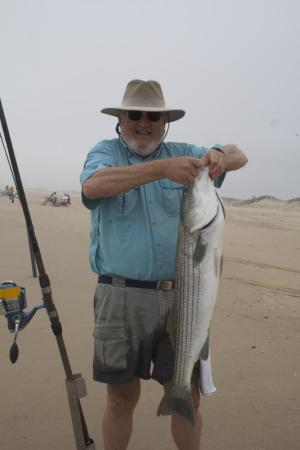March is supposed to come in like a lion and go out like a lamb. Well, if the rest of the month is like the first day of spring, that lamb will be frozen lamb chops. The low at my house on Monday morning was 24 degrees, and the water temperature at the Delaware Lightship Buoy was 44.8 degrees. Both are a long way from ideal for any type of fishing.
Sooner or later, the air and the water will warm up, and the fish will move within range of Delaware shore fishermen. Spring is prime time for those of us who fish from land, because this is when the shallow water close to shore will warm before the deeper water offshore begins to heat up. Flounder, shad, blues, stripers, and even red and black drum will be available from shore. All anglers have to do is figure out when, where and what bait to use.
Over the past few years I have had very good luck catching hickory shad at Indian River Inlet. I fish just under the inlet bridge on the northside. I use a Tsunami metal lure in the 1-1/2- to 2-ounce size with a shad dart tied about 8 to 10 inches behind. I like an incoming current and will cast into the rip and allow the rig to sink down before beginning my retrieve. I will retrieve the rig with a twitch-like action, pausing every so often. That is when the shad usually strikes.
Anglers are allowed 10 hickory shad a day. They are full of bones and the meat does not suit my taste, so I let them go.
Shad are in the same family as tarpon and will put up quite a fight when taken on light tackle. They like to jump clear of the water, and when they get sideways to the current, they can take drag.
Use a Tsunami Saltx 4000 reel with 20-pound braid on a Tsunami Air Wave Elite Series rod. This outfit will cast the shad rig well out into the rip and is light enough to give plenty of sport to the feisty shad.
Of course, the big prize at Indian River Inlet is the striped bass or rockfish. I wish I could tell you that I had caught a half-dozen 50-pounders there, but the truth is, while I have caught a fair number of rockfish out of the inlet, I doubt any of them would top 10 pounds. Most of my stripers were caught casting bucktails or drifting sand fleas. While it is possible to catch a trophy using either of those techniques, you will stand a better chance using big plugs or live eels at night. Remember, any striped bass under 28 inches or over 35 inches must be released.
I have never been a fan of eeling. So, I have been collecting big plugs for several years and plan to attack the inlet with them as conditions dictate.
I will be looking for incoming water from dusk or just before daybreak. I will work the inlet from places that I think may attract big fish, and also the north and south pockets. I will also look for an east wind that may move bait to the inlet or the beach. I tried this last fall without success.
The Lewes-Rehoboth Canal is another location that is fishable from shore. While the canal is best fished from a boat, it is possible to catch flounder out of there from several shore locations.
If you can fish from the town dock, go there on outgoing water. Cast a bucktail baited with a live minnow or Gulp! twister tail as close as possible to a piling on the Savannah Road bridge. Retrieve the rig to keep a tight line so you can feel a flounder pick up the bait.
Use the same rig at the town park by the old boat ramp. Fan cast the canal to cover as much bottom as possible.
They are building a fishing pier where the old railroad bridge used to be. I have no idea when it will be done, but that should be a good location to fish from shore.
I do expect to see black drum at Broadkill Beach this spring. Peeler crab will be the best bait, and I would not be surprised to see some big striped bass there as well.
The fishing pier at Cape Henlopen State Park will be open soon, and that can be a red-hot fishing spot for everything from spot, croaker and flounder to striped bass and big bluefish. It is a great deal since you and the family can fish the whole day for only a $5 park admission.

























































